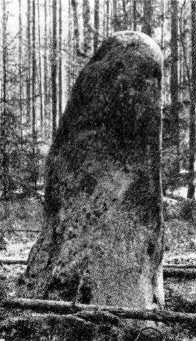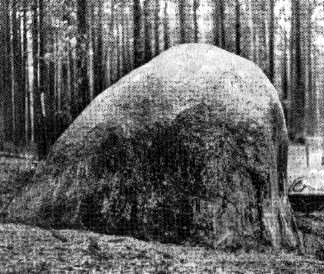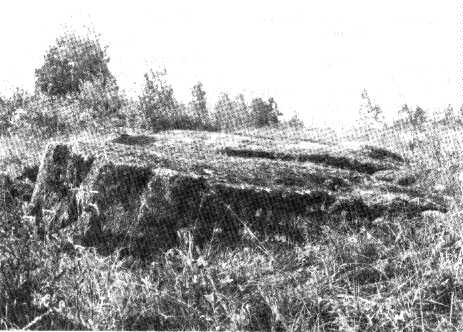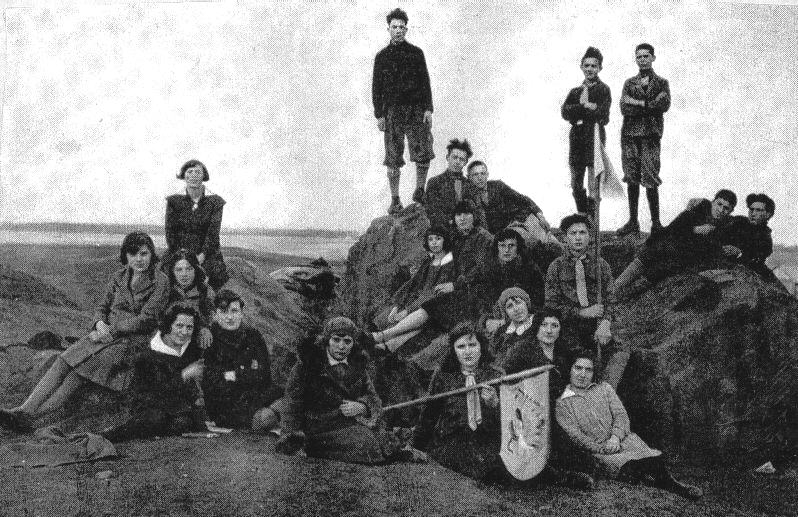Historical and Sacred Stones of the
Belarusian Land
 Belarus lies in the woody middle of the Eastern Europe. The primeval
forests of our land stayed untouched from the moment the Baltic and Slavic tribes have
first stepped into these lands. The landscape of Belarus is rather flat with long
exhausting slopes that go up for miles and then go down again for miles. The highest point
of Belarus Navahrudak - the ancient capital of the Grand Duche of Lithuania - is only some
thousand feet above the sea level. The sandy and woody hills in the North - Paniamonnie
and Padzvinnie - gradually give way to vast flat swampy lands in the South - Palesse.
Entire land is full of rivers and lakes. Deep scratches in the land made by sliding South
glaciers during the Glacier Period have turned into the long chains of lakes extending
from North to the South. These sliding glaciers have brought to Belarusian lands miriads
of stones and boulders broken off the rocky shores of Finland and Sweden. As the stones
were roling they have became rounded, broke into smaller pieces and eventually stayed at
the Southern most border of the glaciers - smack in the middle of Belarus (see the map). Those giant glacier boulders from Scandinavia
have completed their long journey amidst our poor and sandy fields and in the shades of
our primeval forests. The origin of these mysterious and eery stone giants amidst our
lands was unknown to our ancestors. A complex system of folk lore exists around the many
sacred stones with legends and songs describing the stories of their magical appearance.
And so from the pre-historic times our ancestors have worshiped these silent giants. The
largest boulder lies near the village of Horki in Shumilin Region. It is 11 meters long.
Belarus lies in the woody middle of the Eastern Europe. The primeval
forests of our land stayed untouched from the moment the Baltic and Slavic tribes have
first stepped into these lands. The landscape of Belarus is rather flat with long
exhausting slopes that go up for miles and then go down again for miles. The highest point
of Belarus Navahrudak - the ancient capital of the Grand Duche of Lithuania - is only some
thousand feet above the sea level. The sandy and woody hills in the North - Paniamonnie
and Padzvinnie - gradually give way to vast flat swampy lands in the South - Palesse.
Entire land is full of rivers and lakes. Deep scratches in the land made by sliding South
glaciers during the Glacier Period have turned into the long chains of lakes extending
from North to the South. These sliding glaciers have brought to Belarusian lands miriads
of stones and boulders broken off the rocky shores of Finland and Sweden. As the stones
were roling they have became rounded, broke into smaller pieces and eventually stayed at
the Southern most border of the glaciers - smack in the middle of Belarus (see the map). Those giant glacier boulders from Scandinavia
have completed their long journey amidst our poor and sandy fields and in the shades of
our primeval forests. The origin of these mysterious and eery stone giants amidst our
lands was unknown to our ancestors. A complex system of folk lore exists around the many
sacred stones with legends and songs describing the stories of their magical appearance.
And so from the pre-historic times our ancestors have worshiped these silent giants. The
largest boulder lies near the village of Horki in Shumilin Region. It is 11 meters long.
 The Bulls
The Bulls
Perhaps the earliest folklore legends tell the stories of how certain evil magical forces
have turned the living creatures into stones. These two stones remind two European bisons
- zoobrs- in a mortal fight. Neither has been able to win and so they have turned into
stones but did not yield to their challenger.
The Duke-Stone and Sciop-Stone represent men that were turned into stone for they have
angreed the local Gods.


Duke-stone
Sciop-stone
(near Ikany village, Barysau Region)
(near
Krasniki village, Dokshycy Region)
 Piarun-Stone
Piarun-Stone
(near Dubki village, Senna Region)
Piarun is Slavic God of Thunderstorm. Belarusians imagined Piarun as a tall well-built man
with black hair and long golden beard. He is riding in the skies on the horse carriage. He
holds lightning arrows in one hand and a joyful rainbow in another hand. Others thought
that Piarun has huge mill stones in his hands. As he strikes them together the thunder and
sparks - lightnings - appear. The chips of Piarun mill stones fall down on Earth. And so
the flingstones, that were used in the ancient times for stone nifes and axes, are still
called sometimes "Piarun arrows". As a rule Piarun was fighting from the skies
the earthy devils hitting them with lightnings. While he was doing that he would get so
excited that he'd start hitting people and houses. But they say that he usually takes care
of his innocent victims in the skies. Many Piarun-stones are known in Belarus. They were
often used as sacrificial pagan stones.
 Volas-Stone
Volas-Stone
(near the town of Kryzhouka, Minsk Region)
Volas or Viales was a pagan God of prosperity and cattlemen.According to Academician B.
Rybakou the cult of Viales could be traced to Neolithic and even Paleolithic period. This
cult has survived to recent days. TypicallyVolas-Stones are found in the small clearings
in the woods. The sculls of the cattle are decorating trees that sorround it. There will
be a fire and a pagan priest, who can cure diseases and foresee the future. The ancient
traders and travelers would do sacrifices before and after successful enterrprisings to
Volas. The cult of Volas made it into the early 20th century and was fought by Christian
Church.
While Volas was a pagan God of cattlemen, the farmers' God was Dazhdzhbog. Dazhdzhbog
was considered a God of Sun's warmth and rain. Interestingly, the warmth of Sun and the
Sun disk were commanded by different Gods - Dazhdzhbog and Yaryla (later Yur'ya). The
Dazhdzhbog Stones had characteristic depressions in which sacral grain was milled for
sacrificial bread, to ensure future crops.
The pagan God of Death in Belarus was a female God - Mara. Mara also means a
"Dream" in Belarusian. This name could be traced to a Budhist mifology in which
Mara is a male God of Evil and Death. English word "Night Mare" is also
consonant with Mara. And so, the name for our most primal fear of death could be traced
all the way to our common Indo-European ancestors. Typically Mara was described as a dark
shadow that envelops and chokes people. She was capable of turning into any living
creature. But the still look of her eyes reminded a snake. A straw doll of Mara is burned
on Summer Solstice - Kupalle
- after which youth is jumping through the fading fire to stay healthy. The ashes of the
doll thrown in the field guarantee good crops.
In some instances the entire pagan ritual grounds were made out of many oriented and
rearranged boulders in an open fields forming a sort of Belarusian Stonehenge.
 Devil's Mill Stones
Devil's Mill Stones
(near Asavy village, Dokshycy Region)
Most of the Evil forces in ancient Belarusian beliefs were some small local devils,
typically hiding in swamps. The swamps themselves were considered to originate as devil's
spit.The Devil's Stones are usually located in some eery places that become simply
perilous at night or on a foggy day. There were even smaller evil spirits of the forests
and trees - "lesaviki". They would try to confuse you in the forrest, even
answer your calls to make you loose the road and trap you. The mermaids lived in the lakes
and rivers and drown people. Some believed that mermaids can come out of water and hide in
rye fields. From this hideaway they would sneak on you from behind and tickle to death.
That is of course if drowning you is not an option.
 Stone Idol
Stone Idol
(near Dauhinava village, Vilejka Region)
Stone idols or "baba" (symbolizing a female) are frequently found around
Belarus. Their typical shape is that of a rounded cross. You can still see some stone
baba's standing by the road. This particular figure of a woman and a child has
crosses. Each cross consists off 4 crosses joined into one bigger cross. The crosses are
located on the shoulders, heart and stomach area.
Many of the stone idols and sacred stones have symbols carved into them. This is true
not only for Belarusian lands. The Baltic lands in the North - Lithuania, Latvia and
Estonia have similar stones with carved symbols. The symbols could be - complicated
crosses, "envelopes", stars, symbolical boats, people. Out of the known symbols
the circle meant the Sun, C-meant the Moon, wavy line - water, swastics - fire or Piarun -
God of Thunder. Below are some examples of such stones with ancient forgotten symbols.


Some of the stones with ancient symbols in the village of
Staiki, Lahojsk Region.
Later the stones with carved symbols were used by Dukes, ruling Belarusian lands to
designate their lands. Such Barysau, Rahnedau, Rahvalodau stones have appeared throughout
Belarus.
Jewish story about the boulder in
Kurenets/Kurenitz/Kureniec
The Big Boulder legend
By Yosef Weiss written in 1955
On gloomy winter nights, when the Rabbi was praying the Mincha prayer in the synagogue,
we, the little children of the Cheder, would gather around the big
fire place. The descending darkness would stir our imaginations. We would spend the
evening telling horror tales, about witches, spirits, and cursed princes and princesses.
The Rabbi's wife would stand, warming herself by the fire, and listen silently to our
horrible tales. Maybe she found them interesting, or maybe she only smiled in the
darkening room at our naivete. One evening while we sat around the fire place the Rabbi's
wife told us, "Today children, I will tell you a tale. But this tale is about an
occurrence that didn't take place somewhere far in the world, it is something that people
say happened right here. Right in Kurenitz." Our eyes widened in the dark, and our
curiosity knew no limits. Our only worry was that the Rabbi might return from the
synagogue, and the tale would have to be stopped in the middle.
"Do you know what I am going to tell you about?" she whispered, " I am
going to tell you about the Big Boulder; the boulder that you will find far in the field
past Mydell Street. Are you listening, children? Long, long ago, there was no boulder in
that field. Instead, a huge inn stood on the spot the boulder is now. There lived the
innkeeper with his wife and many children. But this man, as you must have heard, was a
miser, who was notorious for his many bad deeds. He never gave alms to the poor and
banished vagabonds and poor men from his inn."
"Then, one day something happened. A beggar passing through the town was going from
door to door in search of alms. He knocked on the innkeepers door and begged for something
to eat and a place to eat. The innkeeper kicked him out of his home, and worse yet, sent
his huge dogs after the poor man. But this beggar was no ordinary beggar. Oh no, this man
was a magic maker and a miracle worker. Immediately, he whispered a magical spell, cursing
the innkeeper and his entire family. Only a minute had passed whenÉ the inn with the
innkeeper's house with all its occupants inside transformed into a big boulder. And today
that very same boulder sits behind Mydell Street. But this my children is not the whole
tale. People say that if you come to the boulder exactly at twelve midnight and you say a
secret message, when you put your ear to the rock you will hear the rooster's crow and the
children cry!"
Of all the children gathered around the fire that night, I was the youngest. And this tale
of the Big Boulder awed and haunted me. I wished with all my heart to see that amazing
boulder. I started begging my friends to walk to the famous place in order to see the
boulder there, with our own eyes. But all the other small children said they would only
visit the Boulder during the festival of Lag Baomer. They planned to bring the colorful
eggs that they got for the holiday, and break them open on the Boulder.
There were many, many days until Lag Baomer, and I was filled with the urge to see the
place at once. Daily I would stand secretly on the roof of our house, and observe from
afar this miraculous place. For a while I was satisfied straining for a glimpse of the
magical boulder, but soon I fell into my familiar longing to actually visit the Big
Boulder.
Every Friday we were let go from the Cheder at noon. The idea soon occurred to me that I
escape for long enough on Friday in order to finally make journey to the Boulder. I spoke
to two of my friends of my plan and finally convinced them to join me. The next Friday
afternoon we were walking through the gardens of Smorgon Street, and on our way. All of a
sudden we came across was a boy with a huge, hulking dog. Of course, we were very scared.
We started sprinting back to the Cheder. My two friends ran swiftly, like leaping deer.
But, unluckily, I was wearing big boots and could not run fast. I lagged behind and the
dog caught a hold of me. ]From then on I didn't dare leave the shtetle. Still, the tale of
the Big Boulder remained constantly in my mind. Finally, the day of Lag Baomer arrived. I
hardly slept the night before, I was so excited. I awoke at dawn. According to the
tradition of our town, the people of Kurenets began taking eggs from the oven where the
chickens were kept, and boiling the eggs in onion. I decorated the egg shells with ink
designs. As soon as the morning prayer had ended, a large group of
children gathered, and we set out our way to the boulder.
My heart was pounding as I walked. Eventually we arrived at the boulder, and stood before
it. It rose, hulking and black, out of the middle of the field. It certainly did look like
a large house. I stood in front of the boulder, curious and sad. In my imagination I saw
the big inn. The owner, clearly, had not been a descent man. Nevertheless, I pitied him
and his pitiful family for the horrible punishment that was theirs. I stood there
dreaming. All of a sudden, an older boy approached me and said, "Hey you! Listen, why
are you standing there dreaming? If you go around the boulder seven times, and if you say
seven times, 'Sits in hiding,' and then put your ear on the boulder, you will hear the
sound of crying children and crowing roosters." I did what he told me. I walked
around the boulder seven times and then I said with deep concentration and intention,
"Sits in hiding," seven times, one after the other. I bent my knees very close
to the boulder and I put my ear against its rocky side to hear the sounds. Alas, I hadn't
known that the trouble maker was only making fun of me. All of a sudden, he pushed my head
into the boulder; my forehead pressed against the smooth rock, my eyes darkened. Instead
of the sound of children crying and roosters crowing, I heard a sharp ringing in my ears.
I was left with a big bruise on my face.
Those were the days of childhood and naivetŽ. I traveled to many places: to far away
lands, and to the tops of the highest mountains which were scattered with huge boulders.
But not one of those boulders left as deep an impression as the Big Boulder in the field
of my little shtetle.
 Kurenets Boulder
Kurenets Boulder
(Latitude: 54¼33' Longtitude: 26¼27' Belarus)
c1929. Members of Hashomer Hatzair (Socialist Zionost youth movement) on top of the
"famous" Kurenets bolder Standing on the rock from right to left; Shlomo son of
Meir Aharon Alperovitz, Michal son of Ben Zion Meirovitch (perished in 1942), Leizer son
of Chaim Velvel Benes. on the far right Yitzhak Gurfinkel hugging Eiyahu son of Alter
Zimerman. between the standing boys sitting Nechamia Alperovich and linning on his
shoulder Dov the son of Avraham Chaim Reyder (perished in 1942) the chimney sweeper.
holding the flag is Yosef Markman, to his top left, Luba nee Gurevich Bardan, to her left
Chaya Sara Shmukler(perished) and sitting on her Henya Dimenstein the daughter of Merka de
bakerke. sitting at bottom right; Sara Eisak, Zlata Zimerman, ?, ?, . Sheina the daughter
of Neta Zimerman (perished in 1942), Chana Alperovitz and Freydale Zimerman. above them
standing Chaya Altman from Dolhinov Street, sitting far left Bela Meltzer and Menuchka
Kupelovitz.
Today some of
the historic stones have been collected in the Museum of
Stones on the outskirts of Minsk. But many of the sacred
stones of Belarus are endangered and need protection. The protection of the sacred
stones of Belarusian land is important for preserving our historical heritage.
References used in this page:
E. A. Liaukou "Silent Witnesses of the Past" (Belarusian:
"Mauklivyia Svedki Minuushchyny" )
Minsk, publishing house "Navuka i tehnika", 199
ISBN 5-33-00626-4
 This file is a part of the Virtual
Guide to Belarus - a collaborative project of Belarusian
scientists and professionals abroad. VG brings you the most extensive compilation
of the information about Belarus on the Web.
This file is a part of the Virtual
Guide to Belarus - a collaborative project of Belarusian
scientists and professionals abroad. VG brings you the most extensive compilation
of the information about Belarus on the Web.
Please send your comments to the authors of VG to
Belarus 
History | Statehood | Culture | Law
and Politics | Cities | Nature and Geography | Travel | Global Resources | Dictionaries | Chernobyl | Genealogy | Industry | New
©1994-04 VG to Belarus
Disclaimer
 Belarus lies in the woody middle of the Eastern Europe. The primeval
forests of our land stayed untouched from the moment the Baltic and Slavic tribes have
first stepped into these lands. The landscape of Belarus is rather flat with long
exhausting slopes that go up for miles and then go down again for miles. The highest point
of Belarus Navahrudak - the ancient capital of the Grand Duche of Lithuania - is only some
thousand feet above the sea level. The sandy and woody hills in the North - Paniamonnie
and Padzvinnie - gradually give way to vast flat swampy lands in the South - Palesse.
Entire land is full of rivers and lakes. Deep scratches in the land made by sliding South
glaciers during the Glacier Period have turned into the long chains of lakes extending
from North to the South. These sliding glaciers have brought to Belarusian lands miriads
of stones and boulders broken off the rocky shores of Finland and Sweden. As the stones
were roling they have became rounded, broke into smaller pieces and eventually stayed at
the Southern most border of the glaciers - smack in the middle of Belarus (see the map). Those giant glacier boulders from Scandinavia
have completed their long journey amidst our poor and sandy fields and in the shades of
our primeval forests. The origin of these mysterious and eery stone giants amidst our
lands was unknown to our ancestors. A complex system of folk lore exists around the many
sacred stones with legends and songs describing the stories of their magical appearance.
And so from the pre-historic times our ancestors have worshiped these silent giants. The
largest boulder lies near the village of Horki in Shumilin Region. It is 11 meters long.
Belarus lies in the woody middle of the Eastern Europe. The primeval
forests of our land stayed untouched from the moment the Baltic and Slavic tribes have
first stepped into these lands. The landscape of Belarus is rather flat with long
exhausting slopes that go up for miles and then go down again for miles. The highest point
of Belarus Navahrudak - the ancient capital of the Grand Duche of Lithuania - is only some
thousand feet above the sea level. The sandy and woody hills in the North - Paniamonnie
and Padzvinnie - gradually give way to vast flat swampy lands in the South - Palesse.
Entire land is full of rivers and lakes. Deep scratches in the land made by sliding South
glaciers during the Glacier Period have turned into the long chains of lakes extending
from North to the South. These sliding glaciers have brought to Belarusian lands miriads
of stones and boulders broken off the rocky shores of Finland and Sweden. As the stones
were roling they have became rounded, broke into smaller pieces and eventually stayed at
the Southern most border of the glaciers - smack in the middle of Belarus (see the map). Those giant glacier boulders from Scandinavia
have completed their long journey amidst our poor and sandy fields and in the shades of
our primeval forests. The origin of these mysterious and eery stone giants amidst our
lands was unknown to our ancestors. A complex system of folk lore exists around the many
sacred stones with legends and songs describing the stories of their magical appearance.
And so from the pre-historic times our ancestors have worshiped these silent giants. The
largest boulder lies near the village of Horki in Shumilin Region. It is 11 meters long. The Bulls
The Bulls 
 Piarun-Stone
Piarun-Stone  Volas-Stone
Volas-Stone  Devil's Mill Stones
Devil's Mill Stones  Stone Idol
Stone Idol 

 Kurenets Boulder
Kurenets Boulder
